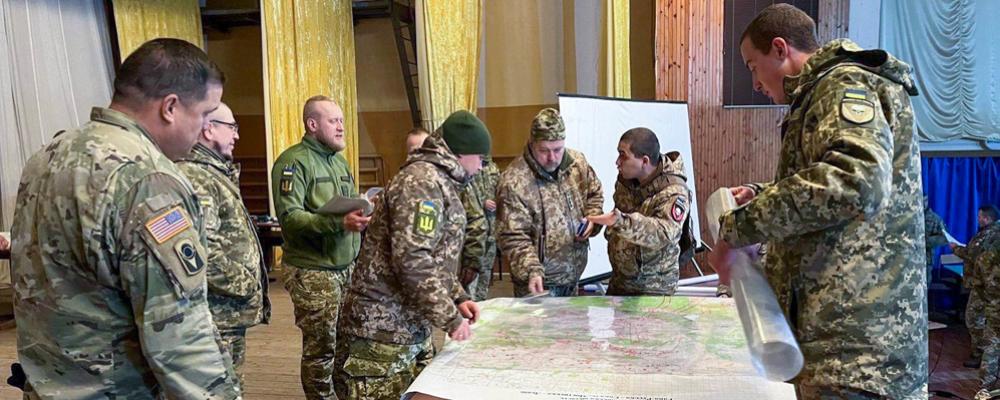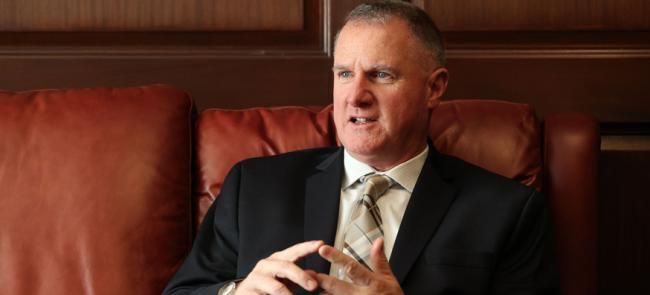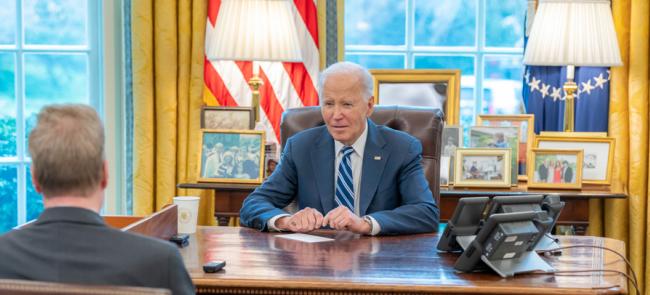
Close to the Fight
It was a "heartbreaking" moment Col. Blake Glass will likely never forget. Sent late last year to Ukraine to help train members of the Ukrainian armed forces to defend their country, Glass and his Florida Army National Guard task force were ordered Feb. 12 to leave the former Soviet republic in its time of greatest need.
He had quickly gotten to know his Ukrainian counterparts, becoming friends as well as comrades in arms. But, with a Russian invasion of the country appearing imminent, U.S. officials didn’t want the 165 American soldiers of Task Force Gator down range.
“Twenty-six years in the military, I’ve had two soldiers killed in combat,” Glass recalls. “Next to that, the hardest thing I’ve done in 26 years was go tell the Ukrainians we were leaving.”
“None of us wanted to leave Ukraine” he adds. “There’s mutual respect for these competent, capable soldiers who have volunteered to fight for their country like American soldiers have volunteered to fight for ours.”
Glass says his Ukrainian counterparts took his news in stride: “Instead of being angry, they just gave us a big hug and said, ‘Thank you for everything. We’re prepared to defend ourselves and we’re ready because of all the help you guys gave us.’”
Task Force Gator was likely the last U.S. unit to leave the country before Russia invaded Feb. 24. It returned home to Florida in late August on a much happier note. The Ukrainians had learned their lessons well, and the Florida Guard soldiers got the chance to train more.
The story begins more than a year ago when the 53rd Infantry Brigade Combat Team received the mission to replace a task force of similar size from the Washington Army Guard’s 81st Stryker Brigade Combat Team.

None of us wanted to leave Ukraine.
—Col. Blake Glass, the commander of the Florida Army National Guard's Task Force Gator
Glass, the brigade commander, would lead the task force. Most of the rest were volunteers from the brigade’s deep pool of combat-seasoned officers and noncommissioned officers, says Maj. Gen. James O. Eifert, the adjutant general of Florida.
“[The brigade] did a good job of cherry-picking people from around the state to get a high-caliber group out there,” Eifert explains. “It wasn’t just headquarters. All of them were pretty much high-speed folks that were ready to go and be trainers stepping off the airplane.”
But those with experience to share typically have significant responsibilities at home.
“It was a long talk with my wife looking at the pros and cons,” says Maj. Michael Lackey, an Active Guard and Reserve officer who also left behind two children to serve as the officer in charge of the task force’s training command advisory team. “But I decided to go. I’m a soldier; it’s part of the job.”
The Guard soldiers reached Ukraine in November. Most went to the Joint Multinational Training Group-Ukraine (see bottom of page) at the Yavoriv Combat Training Center in the Lviv region near the Polish border. Lackey and his four-member team went to Kyiv, the nation’s capital to the northeast, to work with Ukraine’s Land Forces Training Command.
JMTG-U was established in 2015, the year after Russian-backed separatists began fighting Ukrainian forces in the eastern part of the country, to help Ukraine build a Western-style military.
Other nations contribute trainers, but the U.S. has the lead under the 7th Army Training Command. A succession of Army task forces — mostly from the Guard — have taken the mission on a rotational basis.
The cadre use a train-the-trainer approach, which retired Lt. Gen. Ben Hodges, the commander of U.S. Army Europe from 2014 to 2018, says has been critical to moving the Ukrainian military away from its rigid Soviet roots.
“It reinforces the importance of NCOs and junior leaders being responsible for the training of their soldiers and units, which in turns empowers them to use their initiative and make decisions at the lowest levels — a key to success on the modern battlefield,” Hodges says.
Three hours away in Kyiv, Lackey and his team worked with Ukraine’s Land Forces Training Command, planning the continued development of the Yavoriv CTC into a self-sufficient brigade combat training center.
The assignment gave Lackey opportunities to see Kyiv, which he calls “a beautiful place.” One Sunday in late January, with tens of thousands of Russian troops massing on the border, he recalls sitting on a bench in the city and watching people.
“Little kids, couples, a pregnant lady,” Lackey says. “I was thinking, This place could be hit 20 days from now or however long it is. I sat there for a while and just soaked it in. It was sad.”
Lackey and his team were evacuated to the Yavoriv CTC not long after.

The training that we provided Ukrainian soldiers is allowing them to succeed in this war.
—Maj. Michael Lackey of the Florida Army National Guard's Task Force Gator
TASK FORCE GATOR left Ukraine on Feb. 14. U.S. European Command first sent the Florida Guard soldiers to Germany before repositioning them across 15 locations in 11 European countries.
Mostly, they performed odd jobs supporting exercises involving U.S. and other NATO units. Lackey describes the period as a time when “we didn’t feel like we had a purpose.”
The task force got another shock after learning Russian missiles hit the Yavoriv CTC on March 13, killing 35 people and causing extensive damage, according to reports. Glass says the Florida Guard soldiers knew some of those killed and wounded in the attack.
Things turned in April when the 7th ATC brought Task Force Gator back together and stood JMTG-U back up at Grafenwoehr Training Area in Germany, the U.S. Army’s largest training site in Europe.
But instead of training the trainers, the Florida Guard soldiers trained Ukrainian troops directly on how to use new equipment like the M777 155mm towed howitzer and the M142 High Mobility Artillery Rocket System. They found the Ukrainians to be quick studies, often taking less than two weeks to learn how to operate a new system.
“They’re maintenance and technical-savvy,” Glass says. “They can tear something apart, backwards engineer it, figure out how it works, fix it, rebuild it and put it back together again.”
He remembers teaching some Ukrainians how to change a M777 barrel, which needs to be replaced after heavy use. Rather than using a crane like the U.S. troops would, they insisted on changing the barrel by hand, which required 20 troops.
“‘We need to train how we fight,’” Glass remembers the Ukrainians vowing. “They’re going to figure out how to do it themselves.”
Many Ukrainians were fresh off the front lines and eager to get back to the fight. Lt. Col. Jeremy Hopkins, the deputy task force commander, noted the Ukrainians’ sense of urgency during a lunch break in Grafenwoehr.
“One of the Ukrainian soldiers received word that his hometown was being shelled,” Hopkins recalls. “He and his team immediately stopped eating their lunch and went back to training, knowing that that was how they were going to go back and support their homeland.”
Glass says Task Force Gator trained more than 1,600 Ukrainians on as many as 16 different platforms or instruction programs between April and August.
HIMARS and the M777 howitzer have boosted the range and precision of Ukrainian in-direct fires, analysts say.
“The training that we provided Ukrainian soldiers is allowing them to succeed in this war,” says Lackey, who served as a liaison officer between the XVIII Airborne Corps staff, which oversaw JMTG-U in Grafenwoehr, and Task Force Gator.
“Everybody thought Russia was going to overrun Ukraine in days, including Russia. Look where they’re at. Look where Ukraine is at. They’re not stepping down.”
In August, the Florida Guard soldiers turned the mission over to Task Force Orion, which includes 140 members of the 27th IBCT. This is the New York Guard brigade’s second turn at the mission, the only unit in JMTG-U history to do so.
“We know the urgency of this mission and gravity of what the Ukrainian people have at stake,” said Col. William Murphy, the Task Force Orion commander, at the transfer of authority ceremony Aug. 8.
Now home, many members of Task Force Gator keep in touch with their Ukrainian partners via text, social media and communications apps, but they defer to Task Force Orion on training tasks, Glass says.
One of those Lackey stays in touch with is the Ukrainian liaison officer he worked with daily when the task force was in Grafenwoehr.
“I can tell you he’s probably one of the best officers I’ve ever met — that’s American or Ukrainian,” he says. “He has a family and a wife and a kid. They’re still in Ukraine and he’s in Germany doing everything he can to make sure the Ukrainian soldiers are getting the training they need to be successful against Russia.”
“I think it’s a great story. I hope it will be in the end.”
Mark Hensch can be reached at mark.hensch@ngaus.org.

Joint Multinational Training Group–Ukraine
Joint Multinational Training Group-Ukraine is responsible for training, equipping development and doctrinal assistance to the Ukrainian armed forces.
The U.S. Army began the mission at the Yavoriv Combat Training Center in eastern Ukraine in 2015, the year after Russian-backed separatists began fighting Ukrainian troops in the eastern part of the country.
Other nations contribute trainers to JMTG-U, but the U.S. has the lead. A succession of company-sized task forces — mostly from Army National Guard combat brigades — have had the mission.
The first Guard element was from California (79th Infantry Brigade Combat Team), which is linked with Ukraine in the Guard’s State Partnership Program. Task forces from Florida (53rd IBCT), Illinois (33rd IBCT), New York (27th IBCT), Oklahoma (45th IBCT), Tennessee (278th Armored Cavalry Regiment), Washington (81st Stryker Brigade Combat Team) and Wisconsin (32nd IBCT) have also had the assignment.
From the beginning of the mission until January 2022, roughly 23,000 Ukrainians trained at the Yavoriv CTC, said Brig. Gen. Joseph Hilbert, the commander of the 7th Army Training Command, which oversees the JMTG-U, at a Pentagon press conference earlier this year.
Development of a competent noncommissioned officer corps, something Ukraine previously lacked under its old Soviet system, is a point of emphasis, he noted.
Another objective has been to develop the Yavoriv CTC into a self-sufficient brigade-level training center with a permanent cadre and an opposing force.
Many of the Ukrainians training there had seen combat in eastern Ukraine, which has enabled JMTG-U to learn more about the latest Russian equipment and tactics, says retired Lt. Gen. Ben Hodges, the commander of U.S. Army Europe from 2014 to 2018.
So much so, he says, that “we changed our training model at Hohenfels [Joint Multinational Readiness Center] Germany in USAREUR after our first couple of rotations training with the Ukrainians.”
Hodges credits the Guard for the success of JMTG-U.
“The training mission at Yavoriv is a good example where we can do something over an extended, sustained period of time using rotations of Guardsmen,” he says.
JMTG-U left the base when the Pentagon redeployed the Florida Guard’s Task Force Gator on Feb 14. It now operates at the Grafenwoehr Training Area in Germany.
—NGAUS staff report



